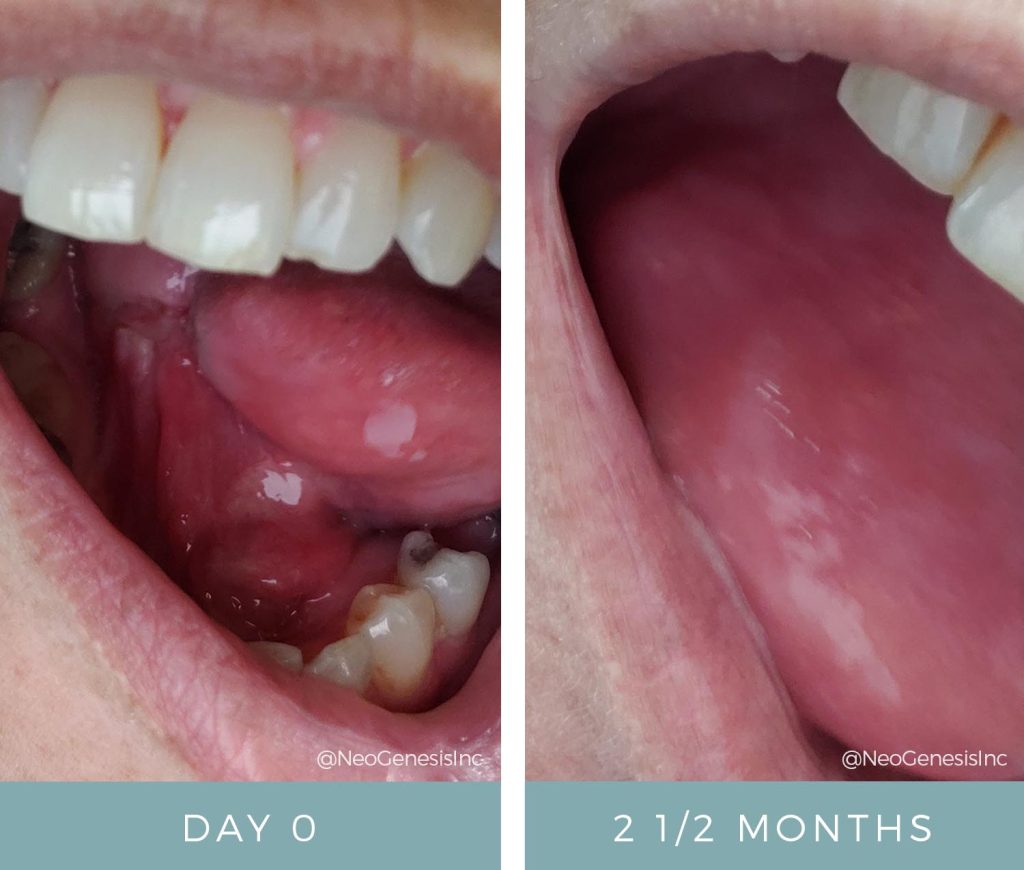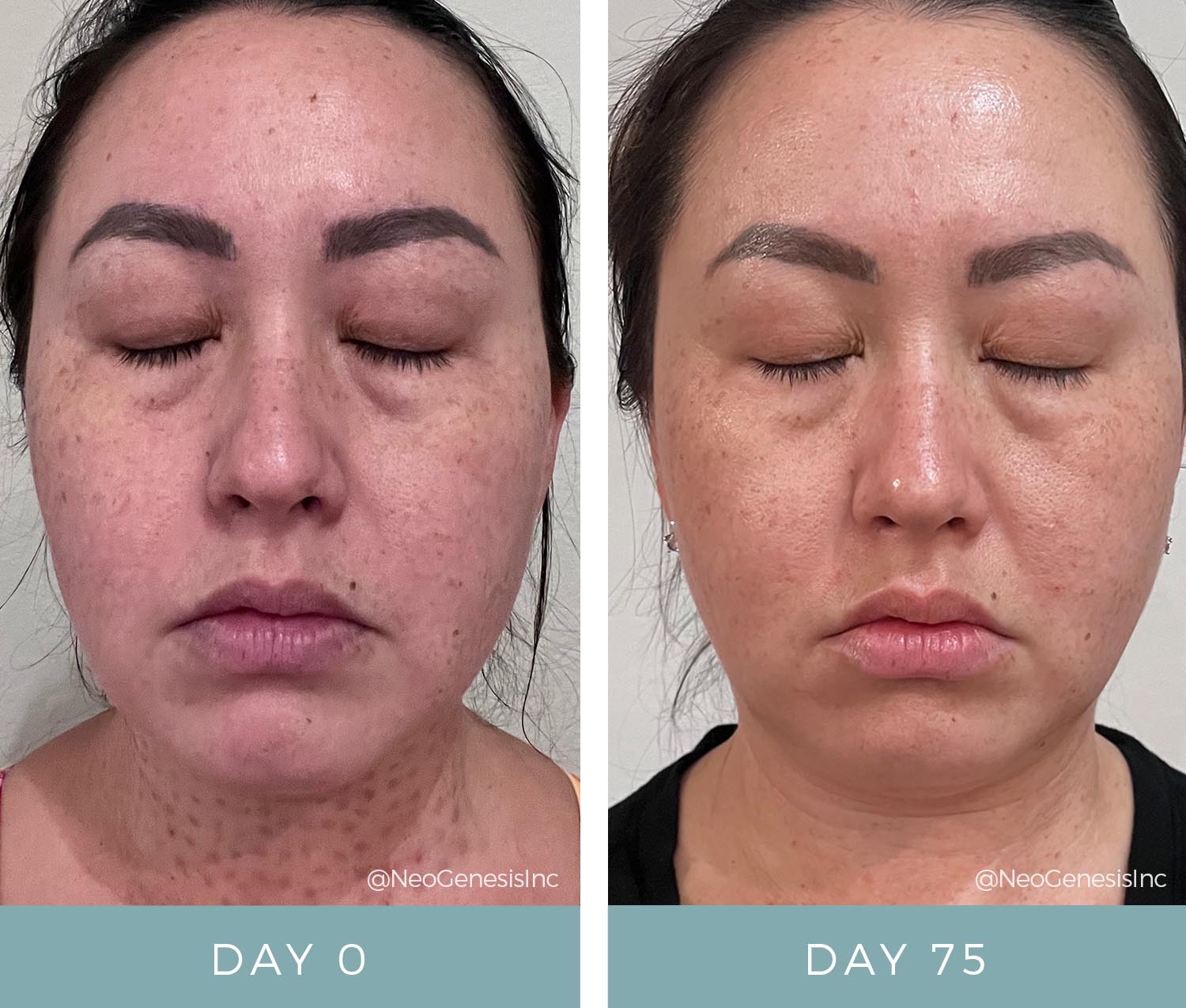Fibroblast Scarring + Aging Skin + Hyperpigmentation

“I have a huge difference in my texture. Especially where I had the fibroblast scarring on my neck and on the bottom of my cheeks, I’m not feeling the bumps from it anymore. And not only am I not feeling the bumps, but my overall texture of my skin is very smooth and soft. It just feels very supple.
Definitely noticing a huge difference under my eyes. I feel like they’ve changed so much. I don’t look as tired. They are less puffy and dark and don’t look as hollow as they usually do.
I see a significant decrease in the wrinkles around my eyes and especially on my forehead.
My pigmentation is definitely getting better too, especially the pigmentation in the scarring around my chin area from the fibroblast. I was wearing makeup on a daily basis because I was trying to hide the scarring, but I’m feeling better just wearing sunscreen and not taking on any makeup. I’m feeling definitely more confident in my skin.” – Sarah F.
PRODUCTS USED:
Cleanser, Recovery, Eye Serum, Mandelic Acid 8%, Barrier Renewal Cream
FEATURED VIDEOS
FIBROBLAST SCARRING + AGING SKIN + HYPERPIGMENTATION
Fibroblast skin tightening is a popular cosmetic procedure that aims to improve the appearance of sagging, loose skin on various parts of the body. It uses a device called a fibroblast pen to deliver tiny plasma sparks to the targeted area, which creates micro-injuries and stimulates the production of collagen and elastin fibers in the skin. This results in tighter, firmer, and more youthful-looking skin.
One of the common concerns associated with fibroblast skin tightening is scarring. As with any cosmetic procedure that involves creating micro-injuries to stimulate the body’s healing response, there is a risk of scarring if proper aftercare instructions are not followed. It is important for patients to keep the treated area clean and protected from sun exposure during the healing process to minimize the chances of scarring.
In addition to scarring, some people may also experience hyperpigmentation after undergoing fibroblast skin tightening. Hyperpigmentation is a condition where patches of skin become darker than the surrounding areas due to an increase in melanin production. This can occur as a result of the skin’s natural response to inflammation and healing, which can be triggered by the micro-injuries caused by fibroblast treatment. However, this is usually a temporary side effect and will fade over time with proper skincare and sun protection.
To avoid scarring and hyperpigmentation after fibroblast skin tightening, it is important to carefully select a qualified and experienced practitioner who follows proper sterilization protocols and provides detailed aftercare instructions. It is also crucial to follow these instructions diligently and avoid picking at the treated area, as this can increase the risk of scarring and disrupt the healing process.

“I have a huge difference in my texture. Especially where I had the fibroblast scarring on my neck and on the bottom of my cheeks, I’m not feeling the bumps from it anymore. And not only am I not feeling the bumps, but my overall texture of my skin is very smooth and soft. It just feels very supple.
Definitely noticing a huge difference under my eyes. I feel like they’ve changed so much. I don’t look as tired. They are less puffy and dark and don’t look as hollow as they usually do.
I see a significant decrease in the wrinkles around my eyes and especially on my forehead.
My pigmentation is definitely getting better too, especially the pigmentation in the scarring around my chin area from the fibroblast. I was wearing makeup on a daily basis because I was trying to hide the scarring, but I’m feeling better just wearing sunscreen and not taking on any makeup. I’m feeling definitely more confident in my skin.” – Sarah F.
PRODUCTS USED:
Cleanser, Recovery, Eye Serum, Mandelic Acid 8%, Barrier Renewal Cream
FEATURED VIDEOS
FIBROBLAST SCARRING + AGING SKIN + HYPERPIGMENTATION
Fibroblast skin tightening is a popular cosmetic procedure that aims to improve the appearance of sagging, loose skin on various parts of the body. It uses a device called a fibroblast pen to deliver tiny plasma sparks to the targeted area, which creates micro-injuries and stimulates the production of collagen and elastin fibers in the skin. This results in tighter, firmer, and more youthful-looking skin.
One of the common concerns associated with fibroblast skin tightening is scarring. As with any cosmetic procedure that involves creating micro-injuries to stimulate the body’s healing response, there is a risk of scarring if proper aftercare instructions are not followed. It is important for patients to keep the treated area clean and protected from sun exposure during the healing process to minimize the chances of scarring.
In addition to scarring, some people may also experience hyperpigmentation after undergoing fibroblast skin tightening. Hyperpigmentation is a condition where patches of skin become darker than the surrounding areas due to an increase in melanin production. This can occur as a result of the skin’s natural response to inflammation and healing, which can be triggered by the micro-injuries caused by fibroblast treatment. However, this is usually a temporary side effect and will fade over time with proper skincare and sun protection.
To avoid scarring and hyperpigmentation after fibroblast skin tightening, it is important to carefully select a qualified and experienced practitioner who follows proper sterilization protocols and provides detailed aftercare instructions. It is also crucial to follow these instructions diligently and avoid picking at the treated area, as this can increase the risk of scarring and disrupt the healing process.






